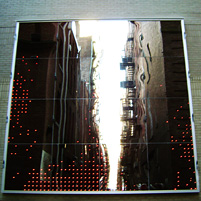Cell Phone Disco

Dial your mobile phone as you walk along Tito Way in Pittsburgh, and you will find yourself part of an art exhibit in the city's cultural district.
A new interactive art installation is now lighting up the areas behind the Benedum theater.
Activated by passersby, the exhibit transforms the electromagnetic cloud of an active mobile phone into the visible frequency of light.
Carnegie Mellon University alumnus Robert Unetich (E'68), founder of GigaHertz, LLC, played a key role in bringing the project to life.
"The Pittsburgh Cultural Trust heard of a similar display in Europe and asked for a demo piece to allow them to consider building a full size version," explained Unetich, an engineer in the field of radio frequency and transmission.
"When the small display was tested in the U.S., they found technical problems due to differences between European cell phone standards and the more diverse collection of U.S. cell phone standards so the project made little little progress in 2009."
Enter Unetich and his firm, GigaHertz.
As a result of some local recommendations, the Pittsburgh Cultural Trust asked Unetich if his company could configure a cell phone signal receiver that could effectively receive the most common U.S. cell phone signals.
Since graduating from CMU as an electrical engineer in 1968, Unetich has worked primarily in the radio frequency transmission field - first as engineer, then engineering manager, entrepreneur and ultimately consultant.
"I looked at the technical issues and did a site spectrum survey that convinced me the technical problems were not difficult," Unetich said.
He determined that receivers of sufficient selectivity and sensitivity tuned to the most used portions of the assigned cellular spectrum would do the job nicely.
His proposal was accepted.
He and his team worked closely with the artists and European engineers to set the sensitivity of each panel of the display to the desired level.
"The final display acts as a mirror when it does not sense electromagnetic energy above its threshold. And it shines red light through the mirror glass when sufficiently strong signals are detected," Unetich said.
The full assembly was completed in Nov. 2010, Unetich happily noted, "Just in time to avoid building in very cold weather."
Related Links: Cell Phone Disco | Pittsburgh Cultural Trust | College of Engineering
